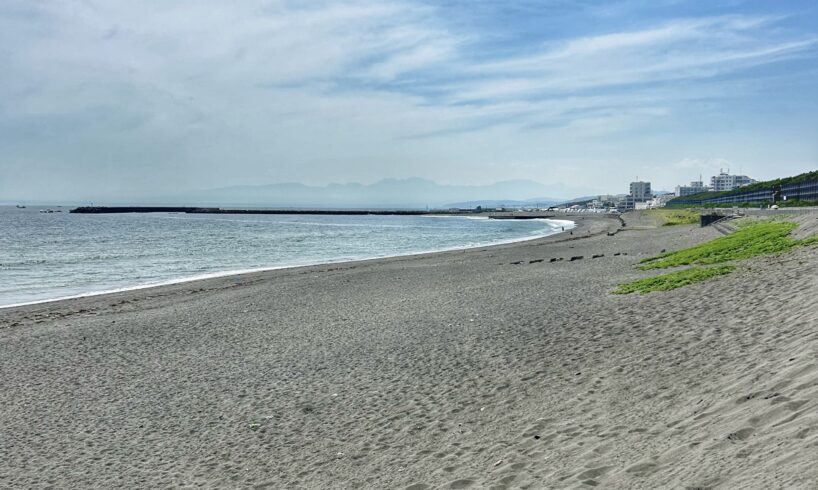
As you get off the train at Chigasaki Station, a surf and beachwear store greets you just outside the ticket gate. Less than an hour away from Tokyo, it is home to the famous music group Southern All Stars. Along with its neighboring city, Hiratsuka, it makes for the perfect day trip for those seeking a summer escape from the asphalt network of Japan’s capital city.
Most people commonly associate the Shonan area with swimming and surfing, and rightfully so. However, it’s also an alluring destination for foodies.
Pain de Nanosh
A natural first stop for those getting off at Chigasaki Station is the famous bakery, Pain De Nanosh. Founded in 2000, it is known for its sourdough. The shop also bakes its bread in an oven that uses lava rock from Mount Fuji. It produces over 150 varieties each day.
Favorites include the English muffins, pain de campagne with rye, and the peach and sour cream Danish. If you bring your dog along for your day trip, you can give it a baked “bone” with no salt or sugar. The bakery also offers sandwiches to take out. If you’ve got a particularly large group of people, it is recommended to reserve bread through the website. It will be ready for you upon arrival.
See here for more information.
Menya Bisq
At Menya Bisq, customers can enjoy a refined bowl of tsukemen (dipping ramen). The wheat noodles are smooth, flat, straight and made in-house. They are very easy to slurp thanks to the kombu-sui (kelp broth), which is packed with umami and slightly viscous. The dark and deep soup is made using a blend of soy sauce, chicken and dried fish. It is hearty yet light enough to not overpower the delicate aspects of the noodles and kombu.
The other ramen on the menu is similarly light, which is good for travelers looking to hit the ocean after lunch. The salt ramen with chicken soup is very popular, as is a side order of the homemade shumai.
See here for more information.
Chigasaki Art Museum
The perfect way to stretch your legs between snacks is a visit to the Chigasaki Art Museum. Designed by architect Yoichiro Yamaguchi, the layout is inspired by the local area. The roof resembles a bird with its wings spread, and the windows are open and luminous. It evokes feelings of the sea and sand.
The museum is nestled within the Takasago Green Space, once a historic sand dune and pine grove. The remains of the former residence of renowned Meiji-era actor Otojiro Kawakami still rest quietly among the towering pines. With the soft rustle of the trees and sunlight filtering through the branches, it feels far removed from the stresses and strains of the city.
The museum houses a collection of over 2,000 works, most of which feature artists from the Kanagawa region. From oil paintings of cherry blossoms at night to watercolor scenes of Sagami Bay’s coastline, the museum offers a cultural escape and an enriching experience for anyone exploring the Shonan area.
See here for more information.
Plenty’s Ice Cream
Plenty’s is a hidden gem in Chigasaki and one of the most compelling reasons for foodies to visit the Shonan coast. The interior is styled like a 1950s American diner, complete with neon artwork, nostalgic figurines, checkered floors and linoleum tables.
Flavors change monthly, with recent options including chocolate mint, banana, tomato sherbet and cream cheese. Everything is made fresh each morning using 100% milk from local cows at Kakizawa Farm. Waffle cones are especially popular, and it’s common practice to add a few ingredients to your order, such as marshmallows, sprinkles, chocolate chips and brownie chunks.
The ice cream is creamy and packed with flavor, served at just the right temperature. There are also a few indoor tables to escape the heat. Located about halfway between the station and the beach, it’s the perfect treat to savor as you stroll.
See here for more information.
Ran
This watering hole is hard to miss, thanks to its facade, which is designed like a mustard-yellow submarine. The shop’s windows double as portholes and the door forms a cheerful entrance beneath two friendly, anthropomorphic eyes.
Ran, which means orchid in Japanese, is a humble restaurant serving fried rice, gyoza, ramen and a selection of alcoholic beverages. The nautical shopfront suits the eclectic menu perfectly. Whether you’re after a cup of coffee or a draft beer to go with your meal, Ran offers a bit of everything.
Bottles of shochu line the counter, each one labeled with a name tag indicating a loyal local customer who keeps a bottle there. Inside, it feels like you are stepping back in time to half a century ago. A bowl of ramen is just ¥500, and the atmosphere is delightfully retro.
Ran is open for both lunch and dinner, making it the ideal spot for anyone wanting to experience a completely hidden slice of Chigasaki kitsch.
See here for the location.
San by Air Market
If you’re looking for the quintessential beach vibe, San By Air Market is the perfect coastal pit stop as it boasts expansive views of the oceanfront. The open-air terrace welcomes dogs, and the laid-back atmosphere captures everything you’d want from a seaside escape. It’s also a great place to catch the sunset. There’s even live music on occasion, adding to the mellow, seaside charm.
The menu leans into classic beach fare, with refreshing options such as acai bowls and smoothies. The berry lassi smoothie is a vibrant, punchy purple, while the acai bowl is topped with granola, chocolate, chia seeds, peanut butter and banana.
The shop opens from 10 a.m., making it an excellent spot to start your day with a cup of coffee and a fresh, fruity breakfast. For those seeking a more indulgent snack, the donuts and bagels are popular choices among regulars.
See here for more information.
After exploring Chigasaki, it’s worth lacing up your hiking shoes and taking the coastal route to Hiratsuka. Pine trees line the path, and those who put in the effort are rewarded with unobstructed Fuji views. Another option is to use the Hello Cycle service. These rental bicycles have multiple ports along the water. They can be rented by downloading the app. They’re a great option for visitors looking to cover more ground at a faster pace. Thanks to the flat open roads along the beach, it’s a very easy cycling experience.
Regardless of your mode of transportation, you’ll see sunbathers, surfers and people fishing on your travels. Bring your swimsuit and go for a quick dip; there are public restrooms and freshwater showers along the way. You’ll have no trouble working up an appetite on your way to Hiratsuka.
Hiratsuka Gyoko no Shokudō
Hiratsuka is famous for seafood, and the city’s fishery association runs a well-known restaurant that draws visitors from all over the area. Reservations begin by phone at 9 a.m., and those who put in the effort to call will be rewarded with immediate seating when the place opens.
An open kitchen overlooks the bustling seating area, so diners can watch the food being prepared as they wait. Maps of the different fishing companies line the walls, and a walking map of Hiratsuka can be picked up at the cash register. It’s a great first stop to get a feel for the flavor of Hiratsuka’s seafood scene.
Perhaps one of the most famous items on offer is the aji fry (breaded horse mackerel). It truly lives up to the hype with its delicately flaky exterior and meaty filet. A dab of tartar sauce and a zest of lemon is all you need. The portion is surprisingly large. Add a side of shirasu oroshi (grated daikon and baby sardines), which makes for a perfect pairing.
Definitely get a set meal if you’re hungry. The staff will explain each item to you. There are 15 different seafood delicacies. Next door is a himono (traditional dried seafood) shop, so be sure to grab some fish to take home. Prices start at ¥200 a piece.
See here for more information.
Hasekin
A family business that was founded in 1890, Hasekin prides itself on the concept of being “small but authentic.” The historic building has been renovated, yet boasts traditional architecture. A dried fish specialty store, it offers samples to curious visitors. It is hard to top the savory umami of being able to taste fresh katsuobushi (skipjack tuna that has been smoked and thinly shaved).
The product selection is impressive. Foodies could spend hours observing the subtleties between varieties of dried squid, or exploring the different ways to prepare ago (flying fish). A perfect snack for your walk is a pack of thin rice crackers made from local whitefish. And for a souvenir, grab a jar of Tanabata furikake, a blend of mackerel, bonito, nori and sesame. The artwork on the label shows Hiratsuka’s annual Tanabata Festival, one of the largest in Japan.
See here for more information.
Raosyan
Raosyan is a Hiratsuka staple, a ramen restaurant known and loved by locals since 1957. There are only two things on the menu: tanmen and gyoza. Not to be confused with spicy tantanmen, the former is a style of ramen that uses a clear broth with a salt base. The noodles are soft, with a pronounced white flour smoothness.
One of the reasons this ramen stands out is that kansui (alkaline powder) — typically added to ramen noodles to create a chewy texture — is completely omitted here, resulting in noodles that are more reminiscent of udon or somen.
The soup is intensely sour and vinegary. White onions provide both texture and contrast, while the wakame (seaweed) and bamboo shoots are fresh and flavorful in their own right. The broth is a slow-simmered tonkotsu (pork bone), but it remains clear rather than cloudy. Just a kiss of oil tops off the bowl, making it light and easy to finish.
The real star, however, is the house-made chili oil. It blends with the sour broth and transforms the entire bowl. The soft noodles pick up the spice perfectly, thanks to the clean and simple profile. There are two tables in the back in addition to counter seating, making it a reasonable option for hungry families as well.
See here for more information.
Ame to Oto
With its gable roof and airy windows, Ame to Oto, which is just a short walk from Hiratsuka Beach, feels both incredibly out of place and yet perfectly at home. The owner lived in England during her teenage years and is passionate about renovating traditional Japanese houses. She worked with architect Ryuichi Kinoshita, who has been renovating homes since 1975.
This particular property is a dreamy fusion of European and Japanese styles and provides visitors with the opportunity to enjoy the setting over a cup of tea. Take off your shoes at the door and get cozy in one of the rooms of the house while you peruse the menu.
On the menu is a traditional British cream tea, complete with crumbly scones, fresh cream, black tea and homemade jelly. Or you can enjoy the dessert of the day. The espresso is fruity and velvety. There are also more than 10 different herbal teas on offer. If you want to enjoy the sunshine as well as the venue, there are even pet-friendly terrace seats in the back garden.
See here for more information.
Daikoku-an
Originally established 60 years ago as a soba restaurant, Daikoku-an eventually began serving ramen as it grew in popularity. However, it still stays true to its roots and continues to use the same whole wheat flour for its noodles as it originally did for its soba.
Daikoku-an offers a customizable ramen experience, with diners able to choose their preferred noodle firmness from a list of over 10 different textures, categorized by boiling time. However, the chef does not recommend the shortest option of 10 seconds, as it results in a texture that is likely too firm to eat for most people. At the other end of the spectrum, the longest boiling time stretches to six full minutes.
The broth has a classic shoyu (soy sauce) base but is distinctively infused with clams, giving it a subtle and naturally sweet depth. One particularly notable offering is the mochi ramen, which reflects its roots as a soba shop.
The addition of a piece of soft and melty mochi pairs perfectly as it dissolves into the steaming soup. The contrast between the savory, briny broth and the delicate sweetness of the mochi offers a pairing that is both unexpected and satisfying.
See here for more information.
Yggdrasil Brewing
When it’s time to reward yourself after a busy day of exploring Shonan, look no further than an ice-cold, freshly brewed craft beer at Yggdrasil Brewing. Named after the sacred tree of Norse mythology, the shop is decorated with Viking ship-inspired details throughout.
The French owner custom-built the property to house his brewery and to evoke the feeling of stepping inside a traditional Viking vessel. A round porthole-style window marks the entrance, and the interior is filled with the warmth of polished wood. Large glass windows at the back of the bar allow guests to view the brewing process in action.
Yggdrasil Brewing is known not only for its craft beer but also for its house-made mead and cider. The mead is brewed using four different types of honey and finishes with the bright floral note of orange blossom.
The cider is fruity and tart, blending apples with hints of passionfruit. Beer enthusiasts should try the Hanocha, a blonde ale infused with Japanese sencha from nearby Hadano, or the Mashpit Double IPA, which incorporates five varieties of French hops.
For those that are driving, Yggdrasil offers bottles for takeaway, and is also happy to fill growlers or other containers to transport freshly tapped beer back home.
See here for more information.
Ashi Hiratsuka Nishiguchi Honten
Before boarding the train back to Tokyo, a stop at Ashi, a beloved French confectionery shop in Hiratsuka, is a fitting way to end the day. It’s also the perfect place to pick up omiyage (souvenirs) for friends or indulge in one last treat. In business since 1959, Ashi is known for its sweets, the most famous being the Shonan Cheese Pie.
This signature dessert layers sable cookie, pastry crust and Edam cheese, finishing with a dusting of powdered sugar. The combination of savory Edam, buttery sable and flaky pastry creates a balanced, indulgent bite.
For those with a taste for more classic desserts, the shop’s glass display cases are filled with parfaits, Mont Blanc, apple pie and silky vanilla pudding. And if you’re traveling with someone who’s less inclined toward sweets, the cafe menu also includes savory options such as pizza toast, gratin and bacon sandwiches. Conveniently located just outside the West Exit of Hiratsuka Station, Ashi is the perfect final stop before heading home. On a rainy day, the inviting cafe seating offers a cozy spot to enjoy a slice of chocolate cake and a warm cup of coffee.
See here for more information.
Final Thoughts
As you descend to the platform at Hiratsuka Station, murals of Mount Fuji and sun-soaked beaches lined with surfers remind you of the day’s highlights. Whether it was swimming in the ocean, savoring a cone of freshly made ice cream, slurping a bowl of ramen or sipping a craft beer, Chigasaki and Hiratsuka offer a dream itinerary for food lovers. With so many incredible stops, visitors are truly spoiled for choice.
What makes this day trip stand out is its unhurried, spacious layout. Unlike other concentrated tourist spots, this stretch of coastline rewards curiosity and exploration. Friendly locals, scenic vistas, historic buildings and quiet streets come together to create an experience that feels both personal and authentic. And as the train carries you back toward Tokyo, it’s hard not to feel like you’ve uncovered a special slice of the region, one that leaves plenty of reasons to return.





